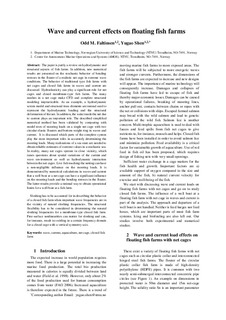| dc.contributor.author | Faltinsen, Odd Magnus | |
| dc.contributor.author | Shen, Yugao | |
| dc.date.accessioned | 2019-04-01T13:33:41Z | |
| dc.date.available | 2019-04-01T13:33:41Z | |
| dc.date.created | 2018-09-26T16:03:18Z | |
| dc.date.issued | 2018 | |
| dc.identifier.citation | Journal of Marine Science and Application. 2018, 1-13. | nb_NO |
| dc.identifier.issn | 1671-9433 | |
| dc.identifier.uri | http://hdl.handle.net/11250/2592745 | |
| dc.description.abstract | The paper is partly a review on hydrodynamic and structural aspects of fish farms. In addition, new numerical results are presented on the stochastic behavior of bending stresses in the floater of a realistic net cage in extreme wave conditions. The behavior of traditional-type fish farms with net cages and closed fish farms in waves and currents is discussed. Hydroelasticity can play a significant role for net cages and closed membrane-type fish farms. The many meshes in a net cage make CFD and complete structural modeling impracticable. As an example, a hydrodynamic screen model and structural truss elements are instead used to represent the hydrodynamic loading and the structural deformation of the net. In addition, the wake inside the net due to current plays an important role. The described simplified numerical method has been validated by comparing with model tests of mooring loads on a single net cage with two circular elastic floaters and bottom weight ring in waves and currents. It is discussed which parts of the complete system play the most important roles in accurately determining the mooring loads. Many realizations of a sea state are needed to obtain reliable estimates of extreme values in a stochastic sea. In reality, many net cages operate in close vicinity, which raises questions about spatial variations of the current and wave environment as well as hydrodynamic interaction between the net cages. Live fish touching the netting can have a non-negligible influence on the mooring loads. It is demonstrated by numerical calculations in waves and currents that a well boat at a net cage can have a significant influence on the mooring loads and the bending stresses in the floater. The latter results provide a rational way to obtain operational limits for a well boat at a fish farm. Sloshing has to be accounted for in describing the behavior of a closed fish farm when important wave frequencies are in the vicinity of natural sloshing frequencies. The structural flexibility has to be considered in determining the natural sloshing frequencies for a membrane-type closed fish farm. Free-surface non-linearities can matter for sloshing and can, for instance, result in swirling in a certain frequency domain for a closed cage with a vertical symmetry axis. | nb_NO |
| dc.language.iso | eng | nb_NO |
| dc.publisher | Springer Verlag | nb_NO |
| dc.title | Wave and Current Effects on Floating Fish Farms | nb_NO |
| dc.type | Journal article | nb_NO |
| dc.type | Peer reviewed | nb_NO |
| dc.description.version | acceptedVersion | nb_NO |
| dc.source.pagenumber | 1-13 | nb_NO |
| dc.source.journal | Journal of Marine Science and Application | nb_NO |
| dc.identifier.doi | 10.1007/s11804-018-0033-5 | |
| dc.identifier.cristin | 1614238 | |
| dc.relation.project | Norges forskningsråd: 223254 | nb_NO |
| dc.description.localcode | This is a post-peer-review, pre-copyedit version of an article published in [Journal of Marine Science and Application] Locked until 14.9.2019 due to copyright restrictions. The final authenticated version is available online at: https://doi.org/10.1007/s11804-018-0033-5 | nb_NO |
| cristin.unitcode | 194,64,20,0 | |
| cristin.unitname | Institutt for marin teknikk | |
| cristin.ispublished | true | |
| cristin.fulltext | preprint | |
| cristin.qualitycode | 1 | |
